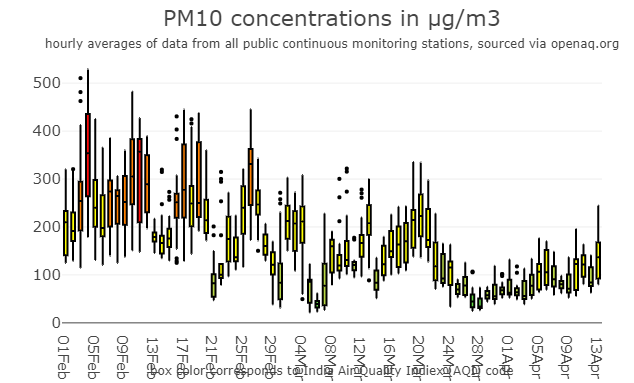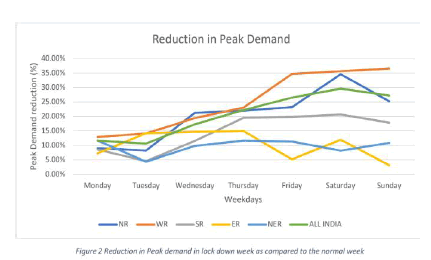Research
, Volume: 17( 1) DOI: 10.37532/environmental-science.2021.17.179COVID-19 PANDEMIC: A miraculous change in environment and a learning moment for green future
- *Correspondence:
- Smriti Dwivedi Department of Applied Sciences, Galgotias College of Engineering and Technology, Greater Noida, U.P, India; Tel: No +91 9910 175 945; Email: s.dwivedi@galgotiacollege.edu
Received: January 11, 2021; Accepted: January 24, 2021; Published: January 28, 2021
Citation: Smriti Dwivedi. COVID-19 PANDEMIC: A miraculous change in environment and a learning moment for green future, J Environ Sci. 2021; 17(1):179
Abstract
COVID-19 is a contagious illness that is caused by a newly recognized coronavirus. It has become the largest pandemic that has issued emergency all across the world. The objective of this research is to show how environment has been positively affected by it particularly in India. Our research shows that although human living and health are our major and immediate issues to concern, water and environmental systems from rural to urban scales have seen noticeable productive impacts due to the depletion of pollutants loading from industries, vehicle emission, and other sources. Seeing the past plots, the research also indicates that the pace and range of improvement seen would have been impossible without supreme actions that have been imposed on the society due to the epidemic, at the cost of several millions of dollars across the nation. Therefore, the research further focuses on how Indiaâ??s environmental problems can be tackled systematically so that country can aim green future even after exemption from the rules of home quarantine that has been imposed due to the ongoing pandemic.Keywords
COVID-19; Environment; Climate; Pollutant; Pandemic
Introduction
The COVID-19(abbreviated as corona virus disease) pandemic, is a happening rampant that was first traced back in November 2019 in the city named Wuhan in China [1].Coronaviruses make up a large family of viruses categorized into four genera namely, α-, β-, γ-, and δ [2] that can infect birds and mammals, including humans, according to world health organization (WHO). Its genetic sequence is very similar to that of SARS as it is caused by Severe Acute Respiratory Syndrome hence it is also known as SARS-CoV2 [3]. It is a single stranded RNA virus having diameter varying from 80 to 120 nm [2]. This infection mainly attacks the respiratory tract by replicating itself in the upper part. The virus is basically disseminated between people during close contact majorly through small droplets produced by coughing, sneezing, and talking. These droplets when fall to the ground, they stay at the surface for a longer period of time and infect the other person when he comes in contact with it. COVID 19 is seen as a mild disease for people in the younger age group while in people above the age of 60 years, the mortality is high [4] so staggered vulnerability of younger generation to infection while protecting the elderly population at home will prevent the rush of cases and alleviate subtle development of immunity in population.
Perceiving the conditions intensifying due to covid-19 every single day the World Health Organization (WHO) announced the breakout a Public Health Emergency of International Concern (PHEIC) [5] on 30 January 2020, and an epidemic on 11 March 2020 as the cases increasingly turned up in more than 188 countries and territories including India which reported its first case on January 30. In order to control the ongoing pandemic, the government of India kicked off a complete nationwide lockdown on March 24 [6], halting all the activities including travel restrictions, workplace hazard controls, and facility closures etc. The epidemic has caused global social and economic turmoil by either postponing or cancelling sports, religious, political, cultural events. Even the schools, universities and colleges have been shut down affecting a large percent of country's student community but this nationwide disturbance caused by the epidemic has resulted in various impacts on the environment and the climate too. In this high time of non-interference of humans in the surroundings, nature has healed itself speedily.
The substantial reduction in planned travel has made a lot of regions to confront a large plop in air pollution. In India’s overpopulated, crowded metropolitan cities, where industries are generally centered and vehicle congestion is some of the worst globally, Air pollution graphs are at their peaks. Also, as per the records of Greenpeace study, eighteen of the 20 highly air contaminated cities in the world are established in India [7]. Pollutants are the prime cause of long-term disorders, including lung disease, diabetes and pneumonia and as per the estimates more than a million Indians die every year because of air pollution-related diseases [8]. The major contributors of smogginess include commercial fumes, vehicular emissions, flaming of litter and crop waste, and construction and road dust.
Discussion
Effect on air quality
When India halted all the activities from March 24 [6] and suspended all transport to manage the spread of coronavirus, the dull skies over its contaminated towns quickly changed to an ultramarine blue, and the air, unexpectedly fresh. The country experienced a drop in air pollution. Reducing air pollution can reduce both climate change and covid-19 risks. Out of blue lockdown led to a bonus in the country. Air quality index (AQI) –cut down by one third between March 16 and April 14. As per the reports of Central Pollution Control Board, at Delhi’s ITO area, AQI reading was marked ‘satisfactory’ as it was reduced approximately by 70% i.e. from 176; it fell to 53 as dated on 31 March, 2020. The situation marked dip in PM 10 [FIG.1]caused mainly by dust of road and construction activities, and nitrogen dioxide, which basically comes from vehicular emissions, and nearly 90% of vehicles are off the road. The average PM 2.5 levels lowered by 22% and nitrogen dioxide — which arises from blazing fossil fuels — descended by 15%. As a result, less than six months ago, Delhi that was heaving for breath, where officials said that air quality had attained "unacceptable levels" and where flights were diverted, and people were asked to wear masks, avoid polluted areas and keep doors and windows closed, now the same city's pollution graph has shown the highest fall in its peak as public transports such as buses, metro set c were put off the road. It improved its average air quality by about a half and hence overjoyed the highest refinement over any mega city. North of India was seen to reduce its AQI by 44%. In New Delhi AQI rose to around 900 in November, breaking the safe limits that are set at 25 by the World Health Organization. But in April, it regularly fell below 20 [8].
Delhi AQI
Source: CPCB, MoFECC
Gujarat’s biggest industrial hub at Ahmedabad, renowned for its cotton textile and diamond industry, has improved its overall air quality significantly. Following the lockdown, it got improved by about 37% in last one year from March 2019 to March 2020.
Ahmedabad AQI
Source: CPCB, MoFECC
As the pandemic-affected home-quarantine proceeded, the quality of water in Ganga and Yamuna rivers has also improved notably in the regions with less commercial action.
Ganga's water which is considered holy by Hindus seems to have increased concentration of dissolved oxygen (DO, a measure of the amount of free oxygen available in river systems) and reduced concentration of nitrate. Its tributaries have also refined due to increase concentration of DO during the lockdown period due to complete closure of industrial operations, vessel movements, fish landing etc which marks as a good indicator for river health. As a result, many mammals including the gangetic dolphins were viewable in the Vikramshila Gangetic Dolphin Sanctuary (VGDS) in Bihar during lockdown period [8]. Sea turtles were observed laying eggs on the beaches they once circumvented (such as at the coast of the Bay of Bengal), due to the minimal levels of human interaction and light pollution. Also outstandingly increase in DO was noticed during COVID-19 phase (precisely 38.54% at diamond harbor, 31.73% at Namkhana and 12.40% in Ajmal Mari) [9] as compared with average DO values at each station since 1984.
Effect on environmental noise
Environmental noise is explained as an unwanted sound that would perhaps be produced by anthropogenic activities (for example, industrial or commercial activities), the transit of engine vehicles, and melodies at high volume [9]. It is one of the main sources of discomfort for the population and the environment, causing various health problems ranging from stress, poor concentration, etc to serious cardiovascular disease, cognitive impairment and altering the natural conditions of the ecosystems. The implementation of quarantine measures by the government has caused people to put up at home. With this, the use of private and public transportation has decreased significantly leading to less honking, no whirr of vehicular engines, no clanking of machinery in factories etc. Also, commercial activities have stopped almost completely. The diurnal decibel level limit in residential areas in normal times is set at 55 db and 45 db at night. But during the lockdown period it just ranges between 30 and 40. The chirping of birds measure around 40-50 db which is higher than that of the surrounding sounds hence people get to hear the sound of nature [10]. All these changes have caused the noise level to drop considerably in most cities.
Effect on carbon emissions
Using several indicators for coal, oil and gas usage, it was estimated that CO2 emissions fell by 30m tones of CO2 (MtCO2, 1.4%) in the economic year ending March, in what is expected to have been the first annual decline in four decades. Additionally, emissions fell by 15% in March and furthermore by 30% in April [11]. This concludes that oil consumption falls by same rate in April as well as in March, which is very probable to be conservative as the national lockdown continued even in the month of May, and gas consumption fell by 15%-20% [11].
Effect on electricity sector
Also, the lockdown period has reduced the peak electricity demand across the electricity regions of the country to a larger extent. [FIG.2] [12].shows that the deduction in percentage in utmost urge across distinct electricity areas of the nation during the quarantine week (23/03 – 29/03) is very high as compared to the normal week (16/03 – 22/03). As depicted in the figure, on and on during the lockdown week, the western region (WR) in the country needed the major peak demand reduction of about 25.19 % followed by northern (NR) with 20.4%, southern (SR) with 14.66%, eastern (ER) with 10.21% and north eastern region (NER) with 9.70%[12].
Effect on flora and fauna
Plants these days have been blossoming up better because there is fresher, oxygenated air and cleaner, purified water, and also since then there is no or very less human intervention. With everything at a halt, plants and trees are allowed to survive and bloom and produce more coverage and oxygen. Also, less litter leads to lesser chocking of river systems. Now moving on to fauna, again if we focus on fishes then the quarantine time period has shown a decline even in fishing rate, which ultimately means that the fish biomass will definitely increase. Apart from that, other animals have also been found roaming about freely where once they would fear to go. Even sea turtles have been seen coming back to areas they once neglected to lay their eggs, all due to the lack human disturbance. Dolphins were also seen at various places such as Haji Ali, Worli, Juhu, and even at Madh Island which in a long run is good for environment [13].
Conclusion
Although country has seen a constructive change in the environment as a result of the lockdown, but on the other handthere is an ongoingfear too of what will be the result when people would start to work again or go back to execute the things that they have been doing earlier. Quarantine time has brought the opportunity to ratio-nalize human act on the environment. Sunil Dahiya, of the Centre for Research on Energy and Clean Air said that "The prevailing pandemic has shown us that clear blue skies and fresh, breathable air can be attained very soon if tangible action is taken to minimize the burning of fossil fuels."
The article showed us how this dreadful virus on one hand is threatening our life and on the other hand it is maintaining the mechanism of the environmental restoration process thereby forcing us to think that how the aim of bagging target economic boom in urban areas, the sources of ecological environment are terribly ignored which leads to various health threats. Hence Dahiya from CREA said that covid-19 crisis presents the country with a chance to invest in a clean energy future. Sri Harsha Kota, one of the report’s authors from Delhi said that, “If the low concentration during the present scenario persisted for about an year, it would approximately protect the lives of 650,000 people, which would have been lost due to air pollution health effects.”
Undeniably, lockdown cannot be the most exemplary solution to bring down various types of pollutions, but it does demonstrate that pollution is human-made and largely we are only responsible for our own misery. In conclusion, the key point to note from this is that once country come to seize with the COVID 19 epidemic, recommendable enactment of the environmental, transport and commercial regulations should be considered asin dispensable to tranquillize the destructive acts of human on the environment. At last the situation gives a lot of motivation and hope that we can bring pollution down.Therefore, various proposals such as reducing road traffic by raising fuel taxes and parking fees, levying congestion charges, creating vehicle-free zones and cycle paths, adopting public transport and zero-emission vehicles with innovative services that are electric (or zero emission), shared and available on demand, switching to clean energy sources for cook stoves etc should be taken as some alternatives to consider in order to meet the need of the demand.
References
- Shrikrushna. A review on corona virus (covid-19). IJPLS. 6. 2020.109.
- UNICEF. 2020.
- Rana M, Kundapur R, Maroof A, et.al. Way ahead - Post Covid-19 Lockdown in India. Indian J Community Health. 2020. 32.
- Sardar, Tridip, Chattopadhyay. Assessment of 21 Days Lockdown Effect in Some States and Overall India: A Predictive Mathematical Study on COVID-19 Outbreak. Air pollution kills 1.2 mn Indians in a year, third biggest cause of death. Business Standard.2020.
- Joe Wallen. India's cleaner lockdown air could save 650,000 lives. The Telegraph.2020.
- Aarushi Koundal. COVID-19 lockdown: Air quality in India’s major industrial cities improves by up to 60% compared to last year. ET Energy World. 2020.
- India's coronavirus lockdown reveals fresh air, cleaner rivers. India Today. 2020.
- Mohd Imran Khan. COVID-19 lockdown a blessing for the endangered Gangetic dolphin in Bihar: Experts. Down To Earth. 2020.
- Mitra, Ankita and Mitra, Abhijit. Enrichment of Dissolved Oxygen in the River Ganges during COVID-19 lockdown. NUJS Journal of Regulatory Studies. 2020.
- M.A. Zambrano-Monserrate, M.A. Ruano, L. Sanchez-Alcalde. Indirect effects of COVID-19 on the environment, Science of the Total Environment, 2020. 728, art. no. 138813
- Myllyvirta, L. and Dahiya, S. Analysis: India’s CO2 emissions fall for the first time in four decades amid coronavirus. Carbon Brief. 2020.
- Sambasivam, B. World’s largest lockdown and its consequences for the electricity sector. The Economic Times; 2020
- Aditi Tandon. India lockdown: Reports of ‘reappearing’ animals are not just misleading – they’re also harmful. Scroll. 2020.





